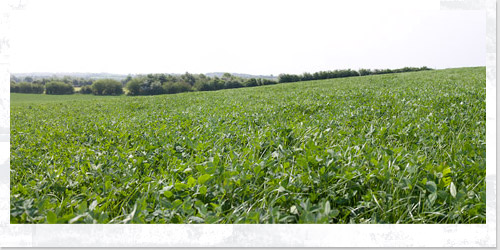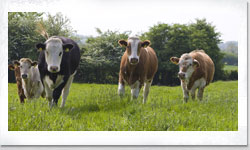
The soil must be man's most Treasured Possession. So He who tends the soil wisely and with care is assuredly the foremost among men. Sir George Stapleton
Why Organic Farming?

During the final three decades of the last century, due to EU regulations, farming production systems in Ireland and across western Europe, became very 'intensive', with the emphasis on maximum production rather than market requirements. This consequently led to over production and the inevitable introduction of 'production limits or quotas'. This has resulted in reduced income from mainstream farming systems and hence the need arose for me to examine other means of land use in order to maintain a viable family income.
I spent a few years looking at a small number of alternatives which might meet my needs and I finally plucked up the courage to go for fully certified Organic farming in 1999. The key issue which swung it for organics was that there was a clear message coming from the market place; 'we want organic food and we are prepared to pay for it'. Therefore, at that time my main reason for changing over to organic production was to 'make more money'.
The experience has been rewarding both in terms of economic returns and job satisfaction.
Respect for the soil
In conventional farming, the tendency is to dominate nature while in organic farming one must work with nature. Being an organic farmer is like being a real farmer again, one must try to understand the science of the soil and work with it, not dictate to it. The better the farmer takes care of the soil, the better the soil will take care of the farmer. The soil beneath our feet has a living world of its own teaming with organisms, some of which are visable to the naked eye e.g. earthworms, but most of which are microscopic in size. We must endeavor through science and experience to understand its needs so that it can continue, with our help, to produce healthy food to feed the people of this world as it has done so well since the beginning of time.
The challenge of successful commercial organic farming is indeed a significant one. In Ireland there are no more than about 1,000 organic farmers with the result that very few operators have much experience in organic farming principles. It is almost akin to starting out as a farmer for the very first time and consequently it is certainly not for the fainthearted. One must be prepared for some disappointments and surprises and anything less than total commitment will not bring success.
Building a fertile soil
Successful commercial organic farming is dependent on a fertile soil which will have an abundant supply of nutrients, especially nitrogen, phosphorous and potassium, in addition to a high population of soil micro-organisms. This is achieved by a system of recycling nutrients around the farm based on a sustainable rotation. The rotation used in Ballard Organic Farm is very simple, two years of red clover / ryegrass followed by three years of cereal growing and back to red clover / ryegrass again.
Free nitrogen

Red clover is a legume and legumes form an essential element of a good organic crop 'rotation'. As well as being a crop in their own right, legumes 'fix' nitrogen (N) from the atmosphere into the soil which is then available for the subsequent crop. This in effect is a supply of 'free' nitrogen. In addition to putting nitrogen into the soil, the crop of clover is harvested three times annually to provide winter feed for the organic cattle on the farm.
Phosphorous and potassium & farmyard manure (FYM)
The remaining nutrient requirement is supplied by the recycling of farmyard manure (FYM) which is produced in the winter time from the housed animals. At the end of the winter housing period, the clamp of FYM is turned over and loosened several times during the summer to incorporate oxygen into the material. This practice facilitates the growth of bacteria which results in the break down of the FYM. This proceedure is essential to ensure that the FYM is in a state which is readily available to nurish the soil.
Cereal crops
The two organic cereal crops currently grown at Ballard Organic Farm are winter triticale (a cross between wheat and rye) and winter oats. Some of the grain is sold to other organic farmers but most of it is fed to my own cattle during the winter housing period.
There are two reasons for choosing triticale and oats. Firstly, because both crops grow quite tall, they control weeds by shading out most of the sunlight from the ground. In addition, oats also has alelopathic properties which act to onhibit the germination of other seeds in its vicinity. Secondly, because Triticale is a hybrid, i.e. a cross between two varieties, it is naturally much more resistant to disease than a single or pure variety.
Regulation of Organic Farming
Organic farming is strictly regulated by EU law. The Irish Department of Agriculture, Food and Fisheries is considered the 'competent authority' for implementing the EU regulations in Ireland. Ballard Organic Farm is certified by the Organic Trust Ltd which is an approved certification body. An organic license is awarded for one year only and operators must re-apply annually to have their license renewed. Operators are subject to an annual audit in addition to unannounced spot checks.
Beef cattle enterprise

There are no mother cows on the farm and consequently young animals must be sourced from other registered organic farmers. These animals are purchased at seven months old during September/October each year. The animals remain on the farm until they are ready for market 18 months later. Visitors to the open farm will receive detailed information on veterinary treatments, feeding regime, winter housing, analysis of feeding materials, costs, outputs, grassland management, animal performance and the recycling of farm yard manures.
The owner
Ballard Organic Farm is owned by Pat Lalor and his family. He is carrying on the family tradition of innovation and enterprise and is a regular contributor to discussions on farming issues on the radio and print media. He has spent five years in agri-politics at national level and has strongly held views (which are very often unconventional), on farming and rural development policies. In 2002 he completed his Diploma in Rural Development in the National University of Ireland-Galway and in 2003 he graduated from the same college with a BA Degree in Training and Education. In the past he has taught on a part time basis, skills in leadership and communications to second-level students, with particular emphasis on the training of student councils.
Award Winner
In 1991 Ballard Farm was one of six Regional winners of the National Development Farmer of the Year competition. This award was given as a result of innovative developments undertaken on the farm over the previous three years. This development focused on the use of concentrates for cattle being mixed with grass silage at the ensiling stage and the establishment of a tree nursery to produce 'white thorn' plants for sale for use in farm hedge rows.
History

Ballard Organic Farm has been owned and operated by the Lalor family since 1844. During the following 100 years the farm was in reality, operated as an organic farm. For the next 50 years, it joined in the industrial revolution which took place in farming involving the use of synthetic chemicals to boost crop and animal production and to control unwanted weeds and diseases.
My late father, Thomas J. Lalor, who passed away in 1987, was an innovator in many ways in modern Irish farming during that era. In July 1939 he erected a windmill for pumping water to cattle, which replaced having to pump by hand. The total cost of the windmill was £47 and every single scrap of documentation regarding the purchase and erection of the windmill is still on file. In the 1940's he was the first to have a Lanz tractor in this area and was the second farmer to buy a Claas combine harvester in the midlands. In 1956 he was the first farmer in Ireland to erect a 'self-feed' silage system, which over the next 25 years became the standard system for winter feeding of cattle. He was also a breeder of pedigree cattle and pigs in his earlier days and was an exporter of store cattle to UK farmers for over 30 years.
